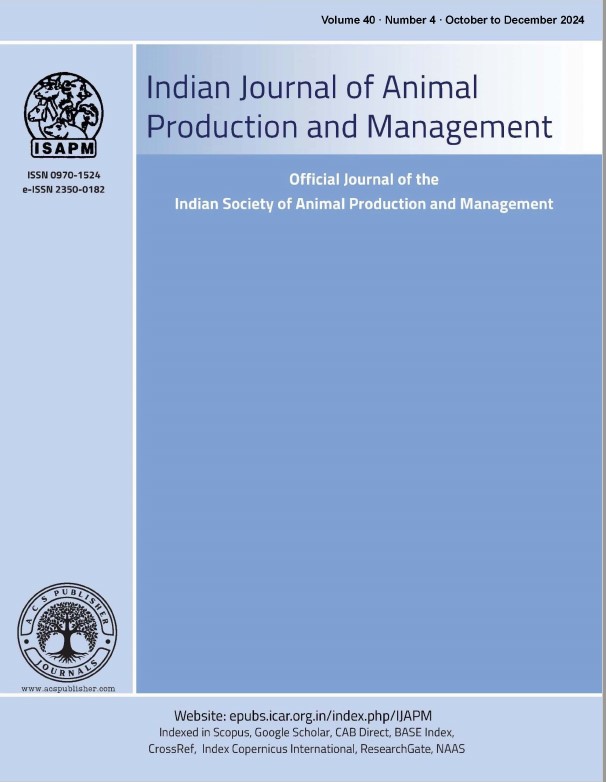Evaluation of Economic Sustainability of Crop and Livestock Integrated Farming Systems Under Rainfed Agriculture
DOI:
https://doi.org/10.48165/ijapm.2025.41.1.3Keywords:
Sustainable livelihoods, Integrated Farming SystemAbstract
Majority of the Indian economy is in the hands of small and marginal farmers with 80% of total land holdings having less than 1ha of cultivable land. Integration of livestock with crop provides scope for effective utilization of byproducts which assures the profitability of the farming system. Integrated Farming System approach is required to enhance the living standards of the small and marginal farmers. The present study revealed the profitable farming systems in major farming situations and its diversification. It was observed that the farming system consisting of seasonal crops along with dairy, sheep and poultry was found most profitable than cultivation of crops alone. The economic sustainability of the faming systems was evolved through Sustainability Value Index (SVI). Most of the farming systems in the rainfed black soils were found sustainable. But only one farming system in rainfed red soils was found sustainable.The Simpson Index of Diversification (SID) was also assessed and observed more diversification in the farming systems under rainfed red soils. The results of the study are useful for small and marginal farmers to adopt the suitable farming system.
References
Boussaada, D., & Yerou, H. (2022). Sustainability’s indicators of sheep farming systems in the eastern steppe ecosystem of Algeria. Genetics and Biodiversity Journal, 6(1), 16–24.
Chatterjee, M. R., Halder, P., & Goswami, R. (2013). Economic characterization of predominant farming systems in West Bengal, India. American Journal of Agriculture and Forestry, 1(3), 40–47.
Chauhan, J. K., Meena, B. S., Meena, H. R., Bhakat, C., Upadhyay, A. D., Lahiri, B., Pal, P., Tengli, M. B., Kumar, S., Chandegara, A. K., & Koreti, K. (2022). Assessment of livelihood security and diversification of tribal dairy farmers in NEH region of India. Indian Research Journal of Extension Education, 22(3), 182–187.
Gopinath, K. A., Srinivasarao, Ch., Chary, G. R., Dixit, S., Osman, M., Raju, B. M. K., Ramana, D. B. V., Saroja, D. G. M., Venkatesh, G., & Maheswari, M. (2014). Improving the productivity of rainfed farming systems of small and marginal farmers in Adilabad district, Telangana. Indian Journal of Dryland Agricultural Research and Development, 29(1), 52–56.
Kaviraju, S., Sredevi, S., Goverdhan, M., & Pasha, M. L. (2017). Characterization of farming systems – A case study in Medak district of Telangana state. Agricultural Economics Research Review, 30(Conference Number), 327.
Kiresur, V. R., Gaddi, G. M., Gummagolmath, K. C., Hiremath, P., & Kulkarni, V. S. (2010). Economic analysis of sustainability of farming systems in hilly zone of Karnataka. Indian Journal of Agricultural Marketing, 24(1), 6–19.
Kumari, & Chauhan, A. K. (2021). Characterization of livestock-based farming systems in tribal areas of Odisha. Indian Journal of Agronomy, 66(1), 81–86.
Panda, M., Nandi, S., Sahoo, U., & Sairam, M. (2022). Integrated farming system for agriculture sustainability. Indian Journal of Natural Sciences, 13(71), 41310–41315.
Reddy, B., Srinivasa Rao, M. M. V., & Padmalatha, Y. (2021). Integrated farming system models. Indian Farming, 71(11), 24–27.
Srinivasa Rao, H., Subba Rao, D. V., Radha, Y., Srinivasa Rao, V., & Rambabu, P. (2019). Profitability of major farming systems in north coastal zone of Andhra Pradesh. International Journal of Agriculture Sciences, 11(11), 8500.

